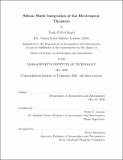Silicon wafer integration of ion electrospray thrusters
Author(s)
Siegel, Noah Wittel.
Download1241077500-MIT.pdf (11.76Mb)
Other Contributors
Massachusetts Institute of Technology. Department of Aeronautics and Astronautics.
Advisor
Paulo C. Lozano.
Terms of use
Metadata
Show full item recordAbstract
Combining efficiency, simplicity, compactness, and high specific impulse, electrospray thrusters provide a unique solution to the problem of active control in the burgeoning field of miniature satellites. With the potential of distributed systems and low cost functionality currently being realized through development of increasingly smaller spacecraft, thruster research must adjust accordingly. The logical limit of this rapidly accelerating trend is a fully integrated silicon wafer satellite. Such a large surface area to volume ratio, however, both necessitates propulsion capability and renders other mechanisms of control unfeasible due to their respective form factors. While development of electrospray thrusters has exploded in the past two decades, current architectures are similarly incompatible with a silicon wafer substrate. This thesis examines the design and testing of a novel hybrid electrospray architecture which combines previous successes of both capillary and externally-wetted geometries. Our project achieved the first passively-fed, pure ionic emission with silicon emitters. More importantly the micro-manufacturing approach offers key advantages in flexibility and overall performance. Through adaption of a innovative approach to black silicon surface treatment, it is possible to tailor hydraulic impedance in order to maximize propellant flow rate and efficiency for a wide range of mission requirements. The manufactured design exhibits operation in the pure ionic mode with 1-ethyl-3-methylimidazolium tetrafluoroborate and has an emitter density more than an order of magnitude larger than any previous electrospray architecture. Preliminary testing indicates that this will likely translate to a corresponding improvement in thrust density. Further, electrochemical degradation of emitter tips - a primary failure mechanism of electrospray thrusters - appears to occur at a relatively inconsequential rate.
Description
Thesis: S.M., Massachusetts Institute of Technology, Department of Aeronautics and Astronautics, May, 2020 Cataloged from student-submitted PDF of thesis. Includes bibliographical references (pages 149-158).
Date issued
2020Department
Massachusetts Institute of Technology. Department of Aeronautics and AstronauticsPublisher
Massachusetts Institute of Technology
Keywords
Aeronautics and Astronautics.